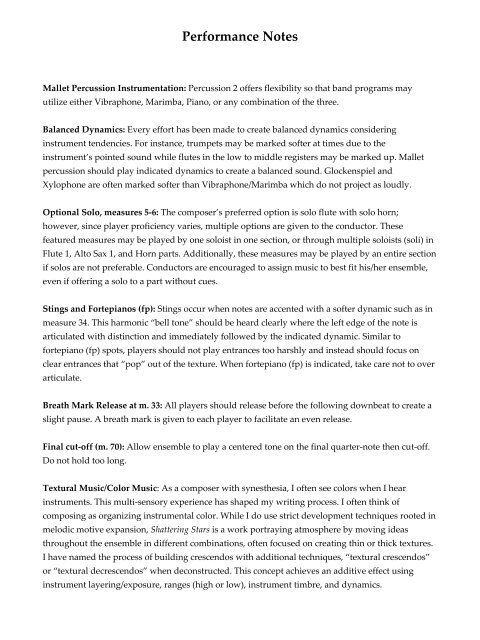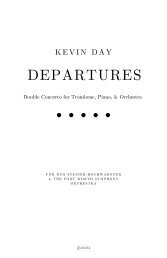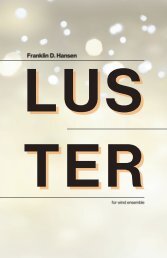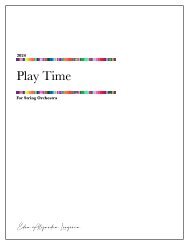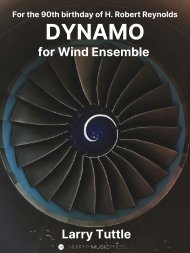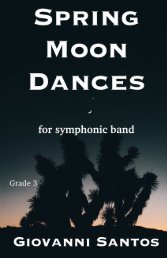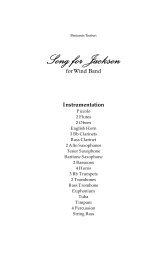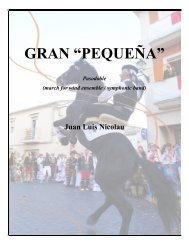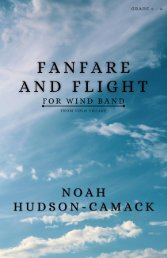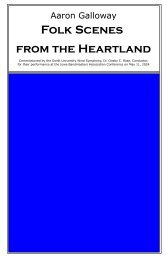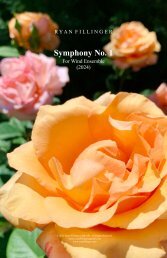Shattering Stars.Score
Create successful ePaper yourself
Turn your PDF publications into a flip-book with our unique Google optimized e-Paper software.
Performance Notes<br />
Mallet Percussion Instrumentation: Percussion 2 offers flexibility so that band programs may<br />
utilize either Vibraphone, Marimba, Piano, or any combination of the three.<br />
Balanced Dynamics: Every effort has been made to create balanced dynamics considering<br />
instrument tendencies. For instance, trumpets may be marked softer at times due to the<br />
instrument’s pointed sound while flutes in the low to middle registers may be marked up. Mallet<br />
percussion should play indicated dynamics to create a balanced sound. Glockenspiel and<br />
Xylophone are often marked softer than Vibraphone/Marimba which do not project as loudly.<br />
Optional Solo, measures 5‐6: The composer’s preferred option is solo flute with solo horn;<br />
however, since player proficiency varies, multiple options are given to the conductor. These<br />
featured measures may be played by one soloist in one section, or through multiple soloists (soli) in<br />
Flute 1, Alto Sax 1, and Horn parts. Additionally, these measures may be played by an entire section<br />
if solos are not preferable. Conductors are encouraged to assign music to best fit his/her ensemble,<br />
even if offering a solo to a part without cues.<br />
Stings and Fortepianos (fp): Stings occur when notes are accented with a softer dynamic such as in<br />
measure 34. This harmonic “bell tone” should be heard clearly where the left edge of the note is<br />
articulated with distinction and immediately followed by the indicated dynamic. Similar to<br />
fortepiano (fp) spots, players should not play entrances too harshly and instead should focus on<br />
clear entrances that “pop” out of the texture. When fortepiano (fp) is indicated, take care not to over<br />
articulate.<br />
Breath Mark Release at m. 33: All players should release before the following downbeat to create a<br />
slight pause. A breath mark is given to each player to facilitate an even release.<br />
Final cut‐off (m. 70): Allow ensemble to play a centered tone on the final quarter‐note then cut‐off.<br />
Do not hold too long.<br />
Textural Music/Color Music: As a composer with synesthesia, I often see colors when I hear<br />
instruments. This multi‐sensory experience has shaped my writing process. I often think of<br />
composing as organizing instrumental color. While I do use strict development techniques rooted in<br />
melodic motive expansion, <strong>Shattering</strong> <strong>Stars</strong> is a work portraying atmosphere by moving ideas<br />
throughout the ensemble in different combinations, often focused on creating thin or thick textures.<br />
I have named the process of building crescendos with additional techniques, “textural crescendos”<br />
or “textural decrescendos” when deconstructed. This concept achieves an additive effect using<br />
instrument layering/exposure, ranges (high or low), instrument timbre, and dynamics.


